2015 FORD EXPEDITION seats
[x] Cancel search: seatsPage 2 of 564

Introduction 9
Child Safety 17
Installing child seats....................................19
Booster seats.........................................29
Child seat positioning...................................32
Child safety locks......................................34
Safety Belts 35
Fastening the safety belts................................37
Safety belt height adjustment.............................40
Safetybeltwarninglightandindicatorchime..................41
Safety belt-minder.....................................42
Child restraint and safety belt maintenance...................43
Supplementary Restraints System 44
Driver and passenger airbags.............................47
Side airbags..........................................48
Safety canopy curtain airbags.............................50
Crash sensors and airbag indicator.........................52
Airbag disposal........................................53
Keys and Remote Control 54
General information on radio frequencies.....................54
Remote control.......................................55
Keys...............................................55
Replacing a lost key or remote control.......................61
MyKey 62
Settings, MyKey.......................................62
Creating.............................................63
Clearing.............................................64
System status.........................................64
Remote start, MyKey...................................65
Troubleshooting, MyKey.................................67
Table of Contents1
2015 Expedition(exd)
Owners Guide gf, 1st Printing, July 2014
USA(fus)
Page 4 of 564
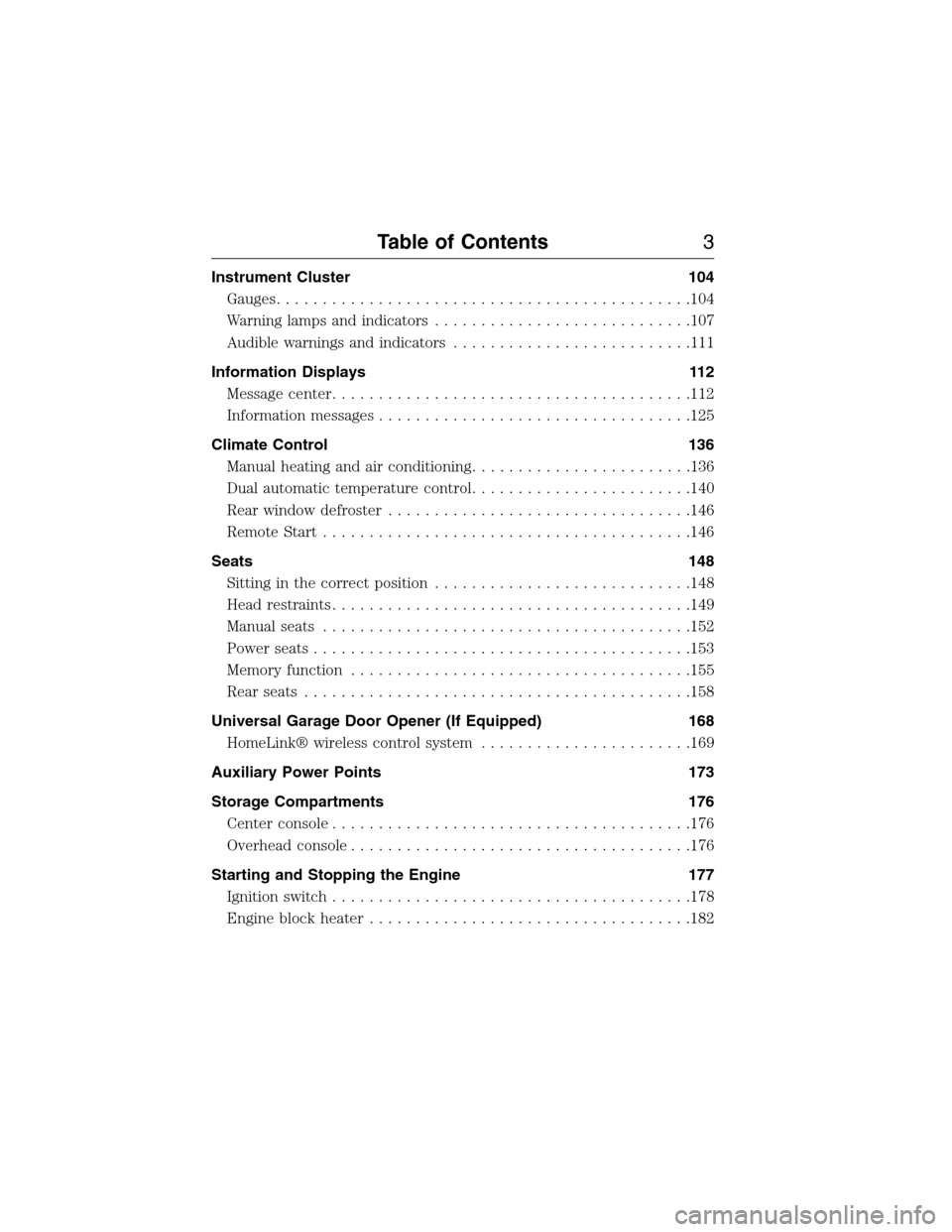
Instrument Cluster 104
Gauges.............................................104
Warning lamps and indicators............................107
Audible warnings and indicators..........................111
Information Displays 112
Message center.......................................112
Information messages..................................125
Climate Control 136
Manual heating and air conditioning........................136
Dual automatic temperature control........................140
Rear window defroster.................................146
Remote Start........................................146
Seats 148
Sitting in the correct position............................148
Head restraints.......................................149
Manual seats........................................152
Power seats.........................................153
Memory function.....................................155
Rear seats..........................................158
Universal Garage Door Opener (If Equipped) 168
HomeLink® wireless control system.......................169
Auxiliary Power Points 173
Storage Compartments 176
Center console.......................................176
Overhead console.....................................176
Starting and Stopping the Engine 177
Ignition switch.......................................178
Engine block heater...................................182
Table of Contents3
2015 Expedition(exd)
Owners Guide gf, 1st Printing, July 2014
USA(fus)
Page 16 of 564
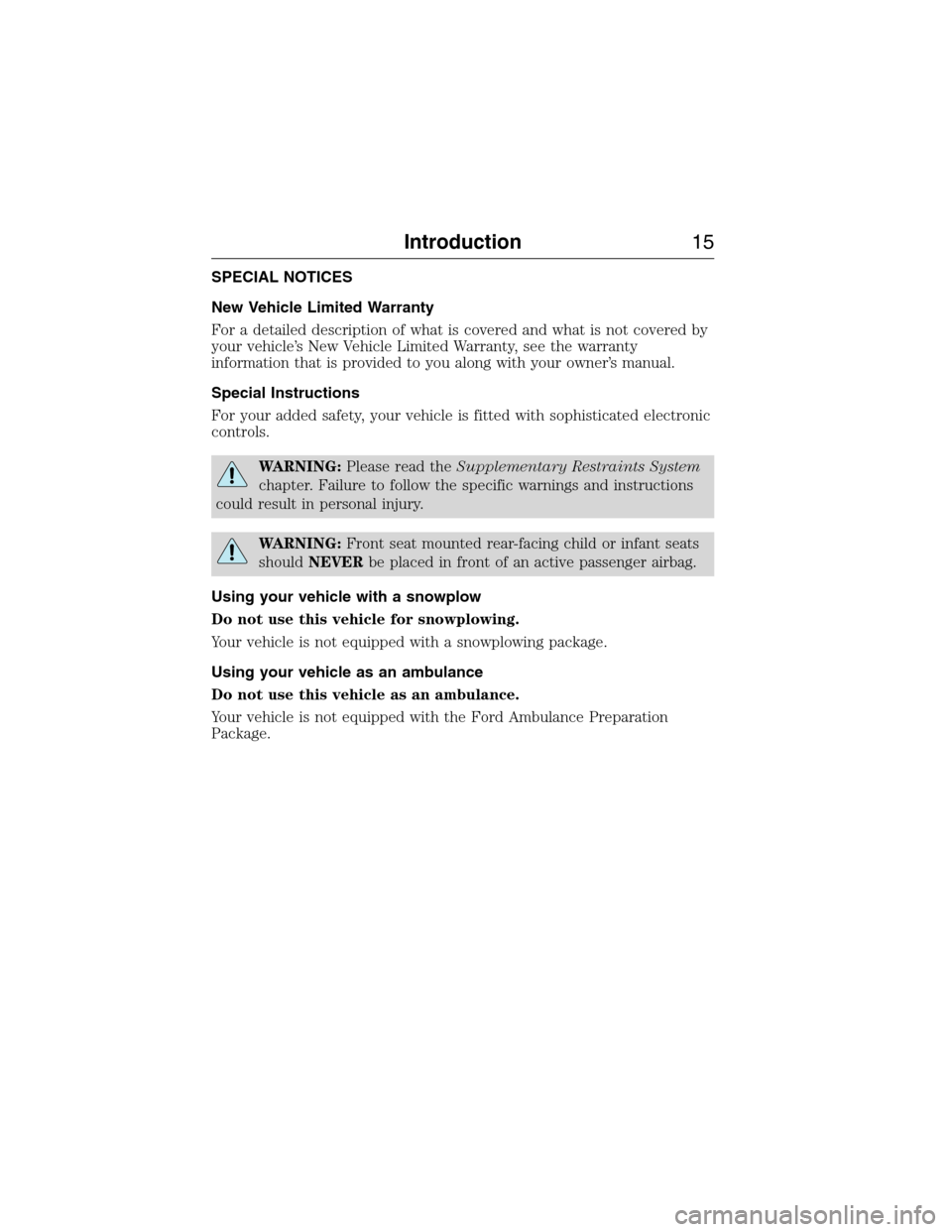
SPECIAL NOTICES
New Vehicle Limited Warranty
For a detailed description of what is covered and what is not covered by
your vehicle’s New Vehicle Limited Warranty, see the warranty
information that is provided to you along with your owner’s manual.
Special Instructions
For your added safety, your vehicle is fitted with sophisticated electronic
controls.
WARNING:Please read theSupplementary Restraints System
chapter. Failure to follow the specific warnings and instructions
could result in personal injury.
WARNING:Front seat mounted rear-facing child or infant seats
shouldNEVERbe placed in front of an active passenger airbag.
Using your vehicle with a snowplow
Do not use this vehicle for snowplowing.
Your vehicle is not equipped with a snowplowing package.
Using your vehicle as an ambulance
Do not use this vehicle as an ambulance.
Your vehicle is not equipped with the Ford Ambulance Preparation
Package.
Introduction15
2015 Expedition(exd)
Owners Guide gf, 1st Printing, July 2014
USA(fus)
Page 18 of 564
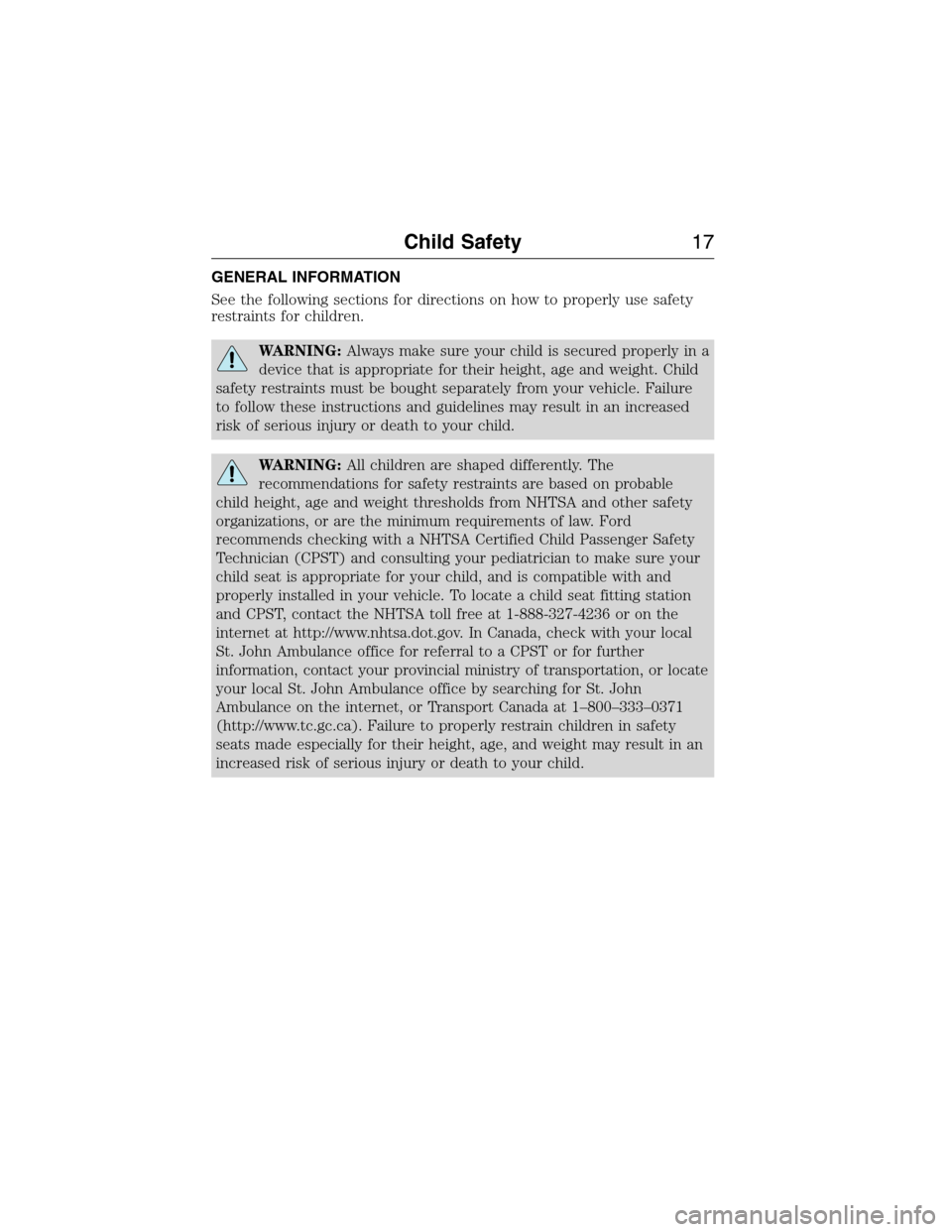
GENERAL INFORMATION
See the following sections for directions on how to properly use safety
restraints for children.
WARNING:Always make sure your child is secured properly in a
device that is appropriate for their height, age and weight. Child
safety restraints must be bought separately from your vehicle. Failure
to follow these instructions and guidelines may result in an increased
risk of serious injury or death to your child.
WARNING:All children are shaped differently. The
recommendations for safety restraints are based on probable
child height, age and weight thresholds from NHTSA and other safety
organizations, or are the minimum requirements of law. Ford
recommends checking with a NHTSA Certified Child Passenger Safety
Technician (CPST) and consulting your pediatrician to make sure your
child seat is appropriate for your child, and is compatible with and
properly installed in your vehicle. To locate a child seat fitting station
and CPST, contact the NHTSA toll free at 1-888-327-4236 or on the
internet at http://www.nhtsa.dot.gov. In Canada, check with your local
St. John Ambulance office for referral to a CPST or for further
information, contact your provincial ministry of transportation, or locate
your local St. John Ambulance office by searching for St. John
Ambulance on the internet, or Transport Canada at 1–800–333–0371
(http://www.tc.gc.ca). Failure to properly restrain children in safety
seats made especially for their height, age, and weight may result in an
increased risk of serious injury or death to your child.
Child Safety17
2015 Expedition(exd)
Owners Guide gf, 1st Printing, July 2014
USA(fus)
Page 19 of 564
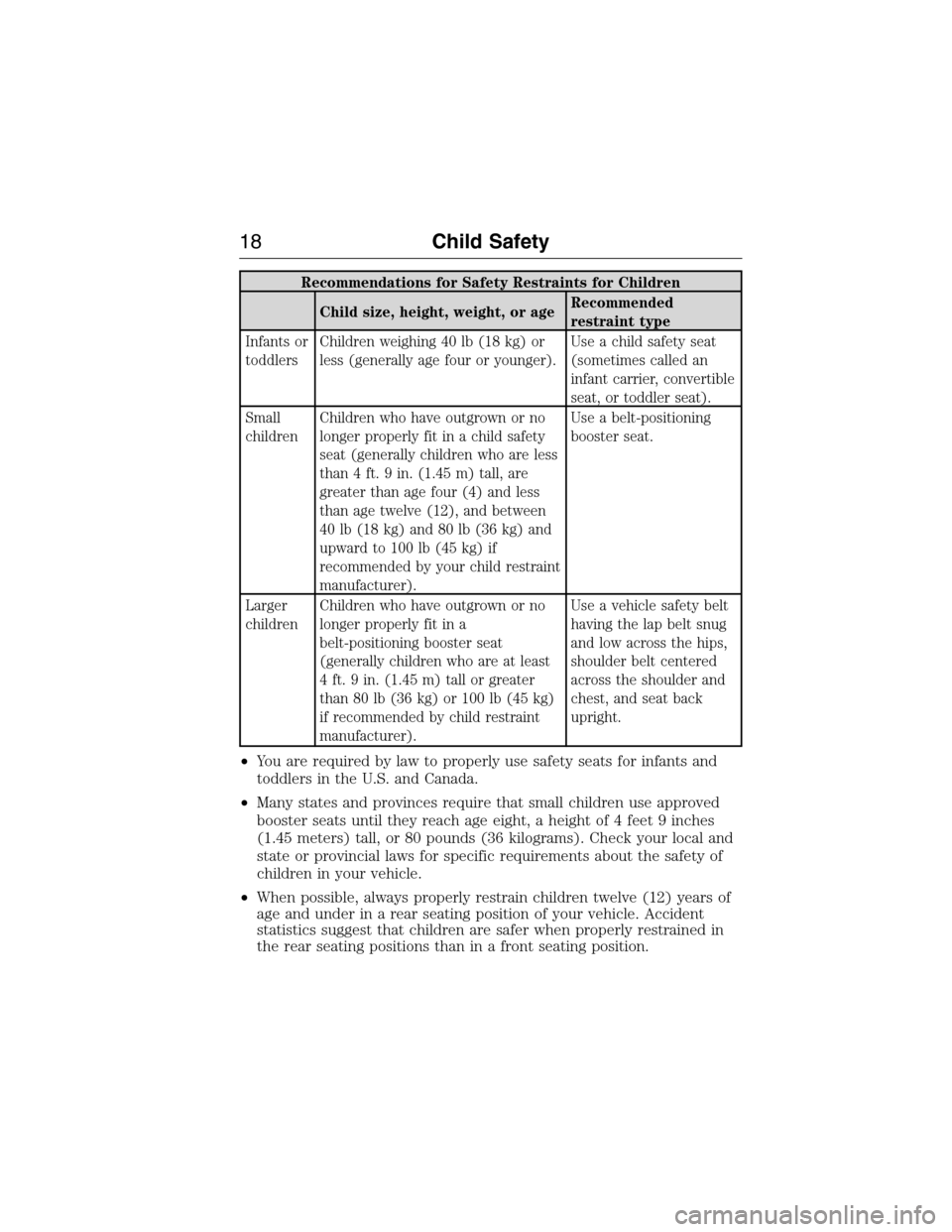
Recommendations for Safety Restraints for Children
Child size, height, weight, or ageRecommended
restraint type
Infants or
toddlersChildren weighing 40 lb (18 kg) or
less (generally age four or younger).Use a child safety seat
(sometimes called an
infant carrier, convertible
seat, or toddler seat).
Small
childrenChildren who have outgrown or no
longer properly fit in a child safety
seat (generally children who are less
than 4 ft. 9 in. (1.45 m) tall, are
greater than age four (4) and less
than age twelve (12), and between
40 lb (18 kg) and 80 lb (36 kg) and
upward to 100 lb (45 kg) if
recommended by your child restraint
manufacturer).Use a belt-positioning
booster seat.
Larger
childrenChildren who have outgrown or no
longer properly fit in a
belt-positioning booster seat
(generally children who are at least
4 ft. 9 in. (1.45 m) tall or greater
than 80 lb (36 kg) or 100 lb (45 kg)
if recommended by child restraint
manufacturer).Use a vehicle safety belt
having the lap belt snug
and low across the hips,
shoulder belt centered
across the shoulder and
chest, and seat back
upright.
•You are required by law to properly use safety seats for infants and
toddlers in the U.S. and Canada.
•Many states and provinces require that small children use approved
booster seats until they reach age eight, a height of 4 feet 9 inches
(1.45 meters) tall, or 80 pounds (36 kilograms). Check your local and
state or provincial laws for specific requirements about the safety of
children in your vehicle.
•When possible, always properly restrain children twelve (12) years of
age and under in a rear seating position of your vehicle. Accident
statistics suggest that children are safer when properly restrained in
the rear seating positions than in a front seating position.
18Child Safety
2015 Expedition(exd)
Owners Guide gf, 1st Printing, July 2014
USA(fus)
Page 20 of 564

INSTALLING CHILD SEATS
Child Seats
Use a child safety seat (sometimes
called an infant carrier, convertible
seat, or toddler seat) for infants,
toddlers or children weighing
40 pounds (18 kilograms) or less
(generally age four or younger).
Using Lap and Shoulder Belts
WARNING:Airbags can kill or injure a child in a child seat.
Never place a rear-facing child seat in front of an active airbag. If
you must use a forward-facing child seat in the front seat, move the
seat upon which the child seat is installed all the way back.
WARNING:Airbags can kill or injure a child in a child seat.
Children 12 and under should be properly restrained in the rear
seat whenever possible.
WARNING:Depending on where you secure a child restraint,
and depending on the child restraint design, you may block
access to certain safety belt buckle assemblies or LATCH lower
anchors, rendering those features potentially unusable. To avoid risk of
injury, occupants should only use seating positions where they are able
to be properly restrained.
When installing a child safety seat with combination lap/shoulder belts:
•Use the correct safety belt buckle for that seating position.
•Insert the belt tongue into the proper buckle until you hear a snap
and feel it latch. Make sure the tongue is securely fastened in the
buckle.
Child Safety19
2015 Expedition(exd)
Owners Guide gf, 1st Printing, July 2014
USA(fus)
Page 22 of 564
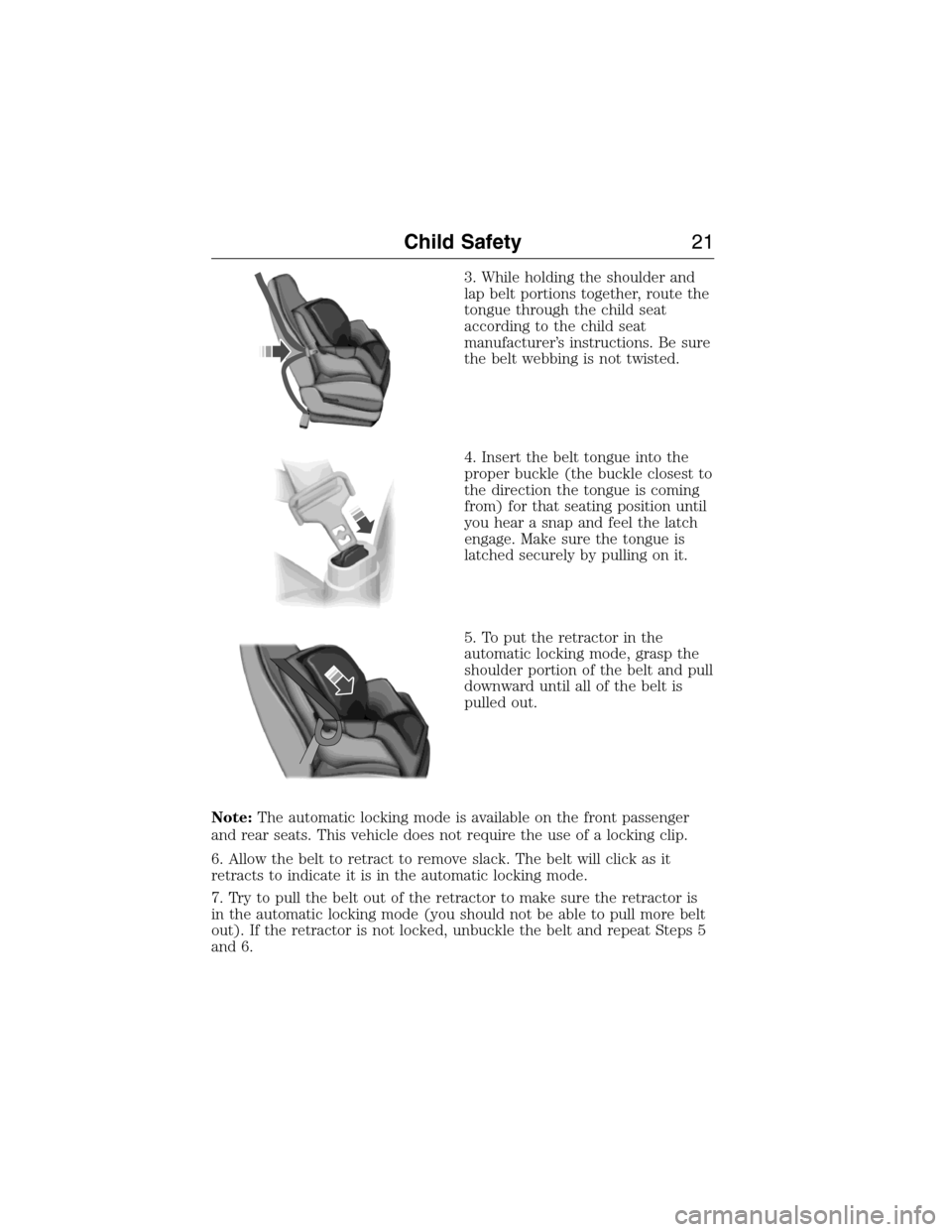
3. While holding the shoulder and
lap belt portions together, route the
tongue through the child seat
according to the child seat
manufacturer’s instructions. Be sure
the belt webbing is not twisted.
4. Insert the belt tongue into the
proper buckle (the buckle closest to
the direction the tongue is coming
from) for that seating position until
you hear a snap and feel the latch
engage. Make sure the tongue is
latched securely by pulling on it.
5. To put the retractor in the
automatic locking mode, grasp the
shoulder portion of the belt and pull
downward until all of the belt is
pulled out.
Note:The automatic locking mode is available on the front passenger
and rear seats. This vehicle does not require the use of a locking clip.
6. Allow the belt to retract to remove slack. The belt will click as it
retracts to indicate it is in the automatic locking mode.
7. Try to pull the belt out of the retractor to make sure the retractor is
in the automatic locking mode (you should not be able to pull more belt
out). If the retractor is not locked, unbuckle the belt and repeat Steps 5
and 6.
Child Safety21
2015 Expedition(exd)
Owners Guide gf, 1st Printing, July 2014
USA(fus)
Page 24 of 564

Using Lower Anchors and Tethers for CHildren (LATCH)
WARNING:Never attach two child safety seats to the same
anchor. In a crash, one anchor may not be strong enough to hold
two child safety seat attachments and may break, causing serious injury
or death.
The LATCH system is composed of three vehicle anchor points: two
lower anchors located where the vehicle seatback and seat cushion meet
(called the seat bight) and one top tether anchor located behind that
seating position.
LATCH compatible child safety seats have two rigid or webbing mounted
attachments that connect to the two lower anchors at the LATCH
equipped seating positions in your vehicle. This type of attachment
method eliminates the need to use safety belts to attach the child seat,
however the safety belt can still be used to attach the child seat. For
forward-facing child seats, the top tether strap must also be attached to
the proper top tether anchor, if a top tether strap has been provided
with your child seat. Ford Motor Company recommends the use of a
child safety seat having a top tether strap. SeeUsing Tether Strapsin
this chapter.
Your vehicle has LATCH lower anchors for child seat installation at the
seating positions marked with the child seat symbol.
Child Safety23
2015 Expedition(exd)
Owners Guide gf, 1st Printing, July 2014
USA(fus)